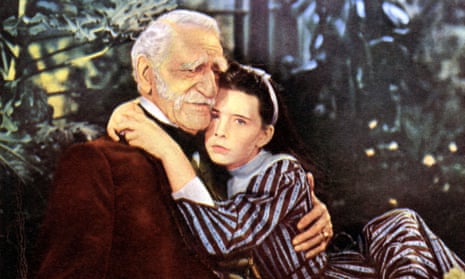We meet the March family just before Christmas of 1862. Mother March – Marmee – works sewing Union Army uniforms. Her 16-year-old daughter Meg is a governess to a wealthy family and her 15-year-old sister Jo is a companion for a rich old relative. Beth, who is 13, has severe social anxiety and is home-schooled, while 12-year-old Amy attends a school of modern mean-girlness. The family employs a cook who does all kinds of household work, but the Marches share the chores. The house is big enough, though shabby, for the family has been genteelly poor since Mr March lost all his money in an unwise loan to a friend; moreover he has volunteered as a chaplain in the Civil War, and is far away in camp. Still, Marmee, who exhorts her daughters to modest virtue, humility, self-sacrifice and sisterly love, will hold them together until Father’s return. The year’s worth of sprightly incidents that follows barely amounts to a plot, the novel reading more like a US television comedy – complete with recurring characters, limited sets, badinage and chat, episodes often ending with a tag-scene moral homily.
I didn’t like the March household at seven, when they were pressed on me as a warm refuge from my own family’s ungenteel poverty – I had a bad reaction to Marmee’s sentimentalised religion, and her belief that the only female vocation is marriage before devoted service to husband and children. It was impossible to dislike Jo, who is author Louisa May Alcott’s self-insertion as a talented literary nerd stomping through a narrow domestic environment. Amy is sharply drawn as a girl who will grow worldly if given the experience; Meg, bound for matrimony, and Beth, doomed to a sanctified death in part two, felt insubstantial, even if they were – as I discovered later – based on Alcott’s sisters. There are a few glimpses of a harsher world outside, as in the opening, when Marmee inspires the girls to give their Christmas breakfast to the children of a destitute immigrant (three of whom later die of scarlet fever offstage), but Alcott pulled a quilt of cosiness – a comforter, as the Americans say – over the Marches. As a child, I couldn’t have explained exactly why they felt phoney, but I was sure there was something much darker to Marmee/Abigail Alcott, and that Jo/Louisa faced more than trivial tribulations.
Decades after, I found Alcott’s 1872 novel Work (Little Women dates from 1868, with its second part, Good Wives, following immediately after in 1869). This story for adults is based on her struggle to earn a living in a precarious economy, and describes how she was reduced to suicidal despair by alternating spells of drudgery and unemployment. But the real revelation was a newspaper essay billed as a chapter from an unpublished memoir, Transcendental Wild Oats, in which she ruthlessly recalled her family’s nadir. Bronson Alcott was painted as an undereducated educational reformer who followed Rousseau-esque progressive notions, but was unable to manage a school. An abolitionist and extreme vegetarian, he even abjured manuring arable land, wearing wool and eating root vegetables, because they ignobly grew downwards. Affecting to live without money, he borrowed it whenever possible. His voice was loud, his word law. He and fellow male utopians fled their brief 1843/4 experiment in transcendental communal living (try Richard Francis’s remorseless exposé, Fruitlands) to wander and prate, abandoning Abigail and her infant girls to survive a bitter winter on a sparse crop of cereals and the apples from 10 trees.
When Abigail came into a small inheritance Bronson took out another loan and bought the first of two houses in Concord, Massachusetts on which Alcott based the March home. He continued to teach, preaching selfless perfection while being both selfish and a failure, and giving TED-type talks which tended to charismatic, new agey nonsense – not for nothing had he started out as a travelling salesman. Abigail was appointed as a social worker in Boston, offering food, fire and moral homilies to Irish incomers fleeing the potato famine. By the time she was in her thirties, Alcott was supporting the family with earnings from journalism and pseudonymous sensational fiction. Bronson and Louisa’s publisher joined forces to persuade her to write a novel for girls – a novel that she always bluntly acknowledged was written quickly, and for money. Despite her frank essay, Alcott never denied or defied Bronson. She continued, unmarried, as his financial and emotional mainstay until his death, dying herself two days after him.
Though Alcott thought it dull to write and read, Little Women is never cynical, always an honest commercial sell. But Father March is a falsity, an emptiness, at its centre, and Abigail’s tougher bravery is missing from Marmee. I wish my family had given me Work instead, a story of how to get by – if not on – that would have been really comforting. But there was no cheap edition of that in Woolworths. It’s the legend that gets printed instead.

Comments (…)
Sign in or create your Guardian account to join the discussion